Sony a9 II Mirrorless Camera Body
BAA Record-low Price!
Dennis Westover is offering a Sony a9 II mirrorless camera body in excellent condition for a BAA record-low $2198.00. The sale includes the original box and everything that came in it including the manuals, one battery, the charger, the front body cap, the strap, the USB cable and cable protector, and insured ground shipping via major courier to lower 48 US-addresses only. Your item will not ship until your check clears unless other arrangements are made.
Please contact Dennis via e-mail.
As things worked out, the a9, and then the a9 ii, turned out to be life-changers for me. From the moment I tracked that first incoming Brandt’s Cormorant at La Jolla, I knew that at that time, the SONY a9 series bodies featured the world’s best AF. I upgraded to the a9 ii as soon as it was released for the slightly larger body size. At one point I owned two a9 ii bodies. A new a9 ii sells for $4,498.00 so you can save an astounding $2300.00 by grabbing Dennis’s a9 ii ASAP. Add a new 200-600 GM (using one of my affiliate links, of course), and you will have a superb Sony rig for bird photography. Note that a new Sony a1 sells for $6498.00. artie
What’s Up?
On Saturday, the first day of the second Homer IPT, I studied the weather forecast carefully, consulted with Captain Gabe, and decided to head across Kachemak Bay at 2:30pm. Though the north wind was not quite perfect, multiple IPT veterans Monte Brown and Robert (“Bear Bob”) Sabine and I had a fantastic session. The eagles were hungry and flying non-stop — we even had our first sunset silhouette chances. After a day of image review Bear Bob made a ton of excellent image.
My favorite David Pugsley image in yesterday’s blog post was #6, the non-breeding plumage Black-bellied Plover pulling the seaworm; I loved the tension created by the taut, angled prey item and the raised foot. The oystercatcher, the ruffling Forster’s Tern, and the Willet with a baby crab were all tied for second.
Today is Sunday 26 February 2023. With more small craft warnings in the forecast, we are unsure of today’s schedule. With snow in the forecast for Monday and Tuesday, we are very excited. We will surely get to review some of Monte’s images and do some more Photoshop. This blog post took more than 90 minutes to prepare (including the time spent on the image optimizations) and makes three hundred thirty-three days in a row with a new educational post written just for you. Wherever you are and whatever you are doing, I hope that you too have a great day.
Please, please, pretty please remember to use my B&H or Bedford’s affiliate programs for all your new gear purchases. If you use B&H, please be sure to click on any B&H link in the blog to start your search. Or simply start with this link. There is always the option of e-mailing me for gear advice and for the correct links.
The plan is to continue to post every day until the streak reaches one year and one day and then begin posting every other day.
Please remember to use the B&H and Amazon links that are found on most blog pages and to use the BIRDSASART discount code at checkout when purchasing your new gear from Bedfords to get 3% back on your credit card and enjoy free second-day air FedEx. Please, also, consider joining a BAA IPT. You will be amazed at how much you will learn!
You can find some great photo accessories (and necessities, like surf booties!) on Amazon by clicking on the Stuff tab on the orange/yellow menu bar above. On a related note, it would be extremely helpful if blog-folks who, like me, spend too much money on Amazon, would get in the habit of clicking on the Amazon logo link on the right side of each blog post when they shop online. As you might expect, doing so will not cost you a single penny, but would be appreciated tremendously by yours truly. And doing so, works seamlessly with your Amazon Prime account.
Please remember that if an item — a Delkin flash card, or a tripod head — for example, that is available from B&H and/or Bedfords, is also available in the BAA Online Store, it would be great, and greatly appreciated, if you would opt to purchase from us. We will match any price. Please remember also to use my B&H affiliate links or to earn 3% cash back at Bedfords by using the BIRDSASART discount code at checkout for your major gear purchases. Doing either often earns you free guides and/or discounts. And always earns my great appreciation.
|
|
|
This image was created on 2 February 2023 at La Jolla, CA. Standing at full height, I used the handheld Sony FE 400mm f/2.8 GM OSS lens and The One, the Sony Alpha 1 Mirrorless Digital Camera). The exposure was determined via Zebra technology with ISO on the Thumb Dial. ISO 800. 1/3200 sec. at f/2.8 (wide-open) in Manual mode. When evaluated in RawDigger, the raw file brightness was determined to be 1/2-stop short of perfect. AWB at 8:11:51am on a cloudy-bright morning. Tracking: Expand Spot/AF-C with Bird Face/Eye detection enabled performed to perfection. Be sure to click on the image to enjoy a high-res version. Image #1: Adult breeding plumage Pacific-race Brown Pelican flying above breaking wave |
Improving My Flight Photography
I had wanted to become a better flight photographer for several decades. I struggled with Canon AF for 34 years. Nikon AF was better, but far from perfect. The Sony a9 and a9ii bodies were a huge improvement. The a1, however, was the realization of my long-term dream of science-fiction-like autofocus with almost instantaneous focus acquisition and deadly face-eye tracking. Yes, AF with the Canon mirrorless bodies and the Nikon Z9 (and previous Nikon mirrorless bodies) is vastly improved. But neither system has Zebras for stills, and the Z9 weighs a ton — 2.9 pounds with a battery and a card. As far as not having Zebras, I have watched Canon and Nikon folks struggle with exposure on recent IPTs while Sony folks are nailing most every one. I am especially proud of multiple IPT veteran Carolyn Johnson who had learned to up the ISO until she sees Zebras on the highlights without being scared of high ISOs.
If you’d like to learn exactly why I feel that the a1 is best by far, please click here.
|
|
|
This image was created on 3 February 2023 at La Jolla, CA. Again, standing at full height, I used the handheld Sony FE 400mm f/2.8 GM OSS lens and The One, the Sony Alpha 1 Mirrorless Digital Camera). The exposure was determined via Zebra technology with ISO on the Thumb Dial. ISO 2000. 1/1600 sec. at f/2.8 (wide-open) in Manual mode. When evaluated in RawDigger, the raw file brightness was determined to be less than 1/6 stop from perfect. AWB at 7:35:14am on a cloudy dark morning. Tracking: Expand Spot/AF-C with Bird Face/Eye detection enabled performed to perfection. Be sure to click on the image to enjoy a high-res version. Image #2: 2-year-old Pacific-race Brown Pelican in flight– wings up landing pose |
The Sony 400mm f/2.8 GM Lens
Somewhat surprisingly, I have really fallen in love with this lens. It absolutely killed for flight in San Diego, and I brought it to Homer while leaving the 600mm f/4 at home. I have used it often on the boat in extreme low light conditions, but the 70-200 f/2.8 GM II lens remains my most valuable in Homer.
It has always been difficult for me to handhold the Sony 600mm f/4 for more than a few minutes at most. Then, fatigue and shoulder pain set in. Though the 400 f/2.8 weighs only four ounces less than the Sony 600mm f/4, I can handhold the 400mm f/2.8 for long flight photography sessions. How can that be? It is much shorter than the 600 f/4 and is far less bulky. In addition, the 400 is much better balanced with more of the weight to the rear of the lens.
And yes, I am quite blessed to be able to own both the 400 2.8 and the 600 f/4. Do understand that for most folks who love birds and can only afford one of these two lenses, the 600mm f/4 is almost always the better of the two, especially for folks who photograph small birds and live in locations where the birds are both distant and skittish.
|
|
|
This image was created on 4 February 2023 at La Jolla, CA. Again, standing at full height, I used the handheld Sony FE 400mm f/2.8 GM OSS lens and The One, the Sony Alpha 1 Mirrorless Digital Camera). The exposure was determined via Zebra technology with ISO on the Thumb Dial. ISO 2000. 1/2000 sec. at f/4 (stopped down one-stop in error) in Manual mode. When evaluated in RawDigger, the raw file brightness was determined to be less than 1-3-stop under. AWB at 7:35:14am on a cloudy dark morning. Tracking: Expand Spot/AF-C with Bird Face/Eye detection enabled performed to perfection. Be sure to click on the image to enjoy a high-res version. Image #3: Adult breeding plumage Pacific-race Brown Pelican flying down the lens barrel |
Flight Photography in San Diego
As you see in this post and in other fairly recent posts, flight photography opportunities abound in San Diego. While the pelicans are large and relatively slow flying, there are plenty of other more challenging subjects. Those include many species of gulls and terns, Black Oystercatcher and Whimbrel, and most especially, the Brandt’s Cormorants that regularly fly in at high speed, of carrying seaweed for their nests. If you would like to improve your flight photography, consider joining me on a San Diego IPT next season.
|
|
|
This all-new card includes images created on my JAN 2022 visit to San Diego. Click on the composite to enjoy a larger version. |
The 2023/2024 San Diego Brown Pelicans (and more!) IPTs
San Diego IPT #1. 3 1/2 DAYS: WED 27 DEC thru the morning session on Saturday 30 DEC 2023. $2099.00. Deposit: $699.00. Limit: 6 photographers.
San Diego IPT #2. 4 1/2 DAYS: TUES 9 JAN thru the morning session on SAT 13 JAN 2024: $2699.00. Deposit: $699.00. Limit: 6 photographers.
San Diego IPT #3: 4 1/2 DAYS: TEUS 23 JAN thru the morning session on SAT 27 JAN 2024: $2699.00. Deposit: $699.00. Limit: 6 photographers.
Please e-mail for information on personalized pre- and post-IPT morning sessions.
Join me in San Diego to photograph the spectacular breeding plumage Brown Pelicans with their fire-engine red and olive green bill pouches; Brandt’s (nesting) and Double-crested Cormorants; breeding plumage Wood and Ring-necked Ducks; other duck species possible including Lesser Scaup, Redhead, Northern Shoveler and Surf Scoter; a variety of gulls including Western, California, and the gorgeous Heermann’s, all in full breeding plumage; shorebirds including Marbled Godwit, Willet, Sanderling and Black-bellied Plover; many others are possible including Least, Western, and Spotted Sandpiper, Whimbrel, Black and Ruddy Turnstone, Semipalmated Plover, and Surfbird; Harbor Seals and California Sea Lions (both depending on the current regulations and restrictions). And as you can see by studying the IPT cards, there are some nice bird-scape and landscape opportunities as well. Not to mention a ton of excellent flight photography opportunities and instruction.
I discovered some really neat spots on my 2022/23 visit. As a result, the first and second IPTs may include an afternoon or two of landscape photography.
Please note: where permitted and on occasion, ducks and gulls may be attracted (or re-located) with offerings of grains or healthy bread.
|
|
|
San Diego offers a wealth of very attractive natural history subjects, including and especially the Pacific race of California Brown Pelican. With annual visits spanning more than four decades, I have lots of photographic experience there … Click on the composite to enjoy a larger version. |
Learning Exposure, Whether You Like It Or Not
Whether you like it or not, we will be beating the subject of exposure like a dead horse. In every new situation, you will hear my thoughts on exposure along with my thoughts on both Nikon and Canon histograms and SONY Zebras. Whether you like it or not, you will learn to work in manual mode so that you can get the right exposure every time (as long as a bird gives you ten seconds with the light constant). Or two seconds with SONY zebras … And you will learn what to do when the light is changing constantly. What you learn about exposure will be one of the great takeaways on every IPT.
|
|
|
Though the pelicans will be the stars of the show on this IPT, there will be many other handsome and captivating subjects in wonderful settings. Click on the composite to enjoy a larger version. |
It Ain’t Just Pelicans
With gorgeous subjects just sitting there waiting to have their pictures taken, photographing the pelicans on the cliffs is about as easy as nature photography gets. With the winds from the east almost every morning, there is usually some excellent flight photography, at times with 70-200mm lenses! And the pelicans are almost always doing something interesting: preening, scratching, bill pouch cleaning, or squabbling. And then there are those crazy head throws that are thought to be a form of intra-flock communication. You will be guided as to how to make the best of those opportunities. Depending on the weather, the local conditions, and the tides, there are a variety of other fabulous photo chances available in and around San Diego. Each IPT will include one or two duck sessions.
|
Did I mention that there are lots of great birds and natural history subjects in San Diego in winter? Click on the composite to enjoy a larger version. |
The San Diego Details
These IPTs will include four or five 3-hour morning photo sessions, three or four 1 1/2-hour afternoon photo sessions, and three or four working brunches that will include image review and Photoshop sessions. On rare cloudy days, we may — at the leader’s discretion, stay out in the morning for a long session and skip that afternoon shoot. To ensure early starts, breakfasts will be your responsibility. And so that we can get some sleep, dinners will be on your own as well. In the extremely unlikely event that Goldfish Point is closed due to local ordinance (or whimsy) — that has never happened in the past fifty years, I will of course do my very best to maximize our photographic opportunities.
|
|
|
San Diego offers a wealth of very attractive natural history subjects, including and especially the Pacific race of California Brown Pelican. With annual visits spanning more than four decades, I have lots of photographic experience there … Click on the composite to enjoy a larger version. |
Deposit Info
A $699 deposit is required to hold your slot for one of the 2023/2024 San Diego IPTs. You can send a check (made out to “BIRDS AS ART”) to us here: BIRDS AS ART, PO Box 7245, Indian Lake Estates, FL, 33855, or call Jim or Jennifer at the office with a credit card at 863-692-0906. Your balance, payable only by check, is due three months before the trip.
|
Variety is surely the spice of life in San Diego. Click on the composite to enjoy a larger version. |
Getting Up Early and Staying Out Late
On all BIRDS AS ART IPTS including and especially the San Diego IPT, we get into the field early to take advantage of unique and often spectacular lighting conditions and we stay out late to maximize the chances of killer light and glorious sunset silhouette situations. We often arrive at the cliffs a full hour before anyone else shows up to check out the landscape and seascape opportunities.
Typos
With all blog posts, feel free to e-mail or to leave a comment regarding any typos or errors.

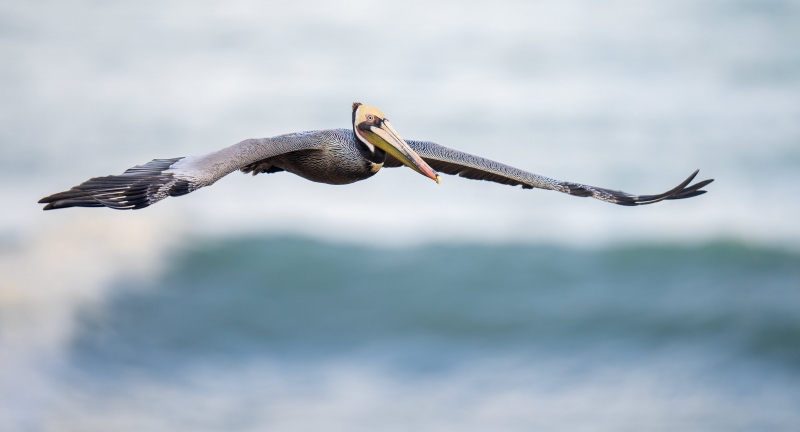
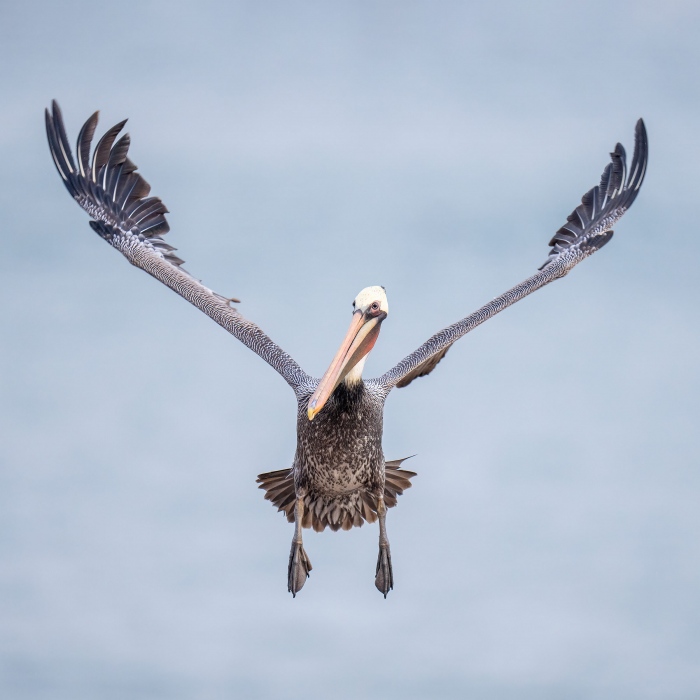
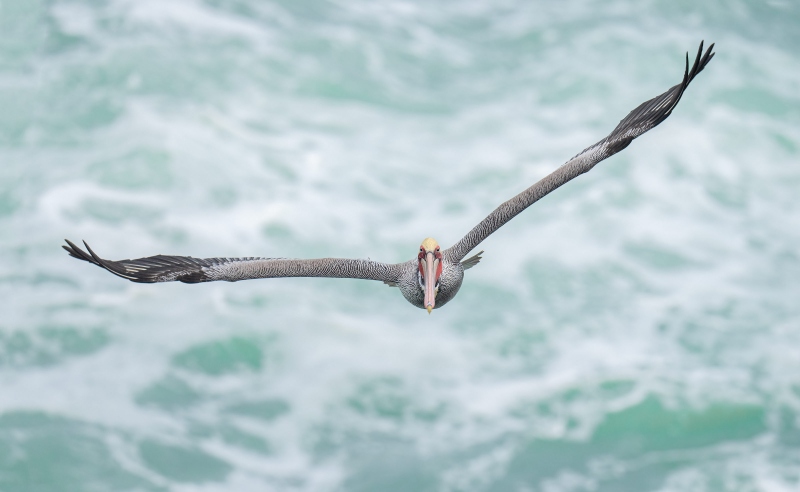
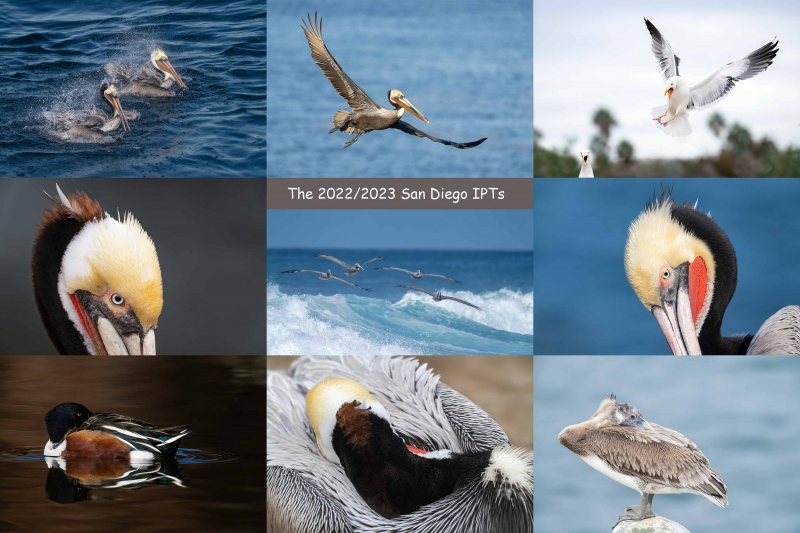
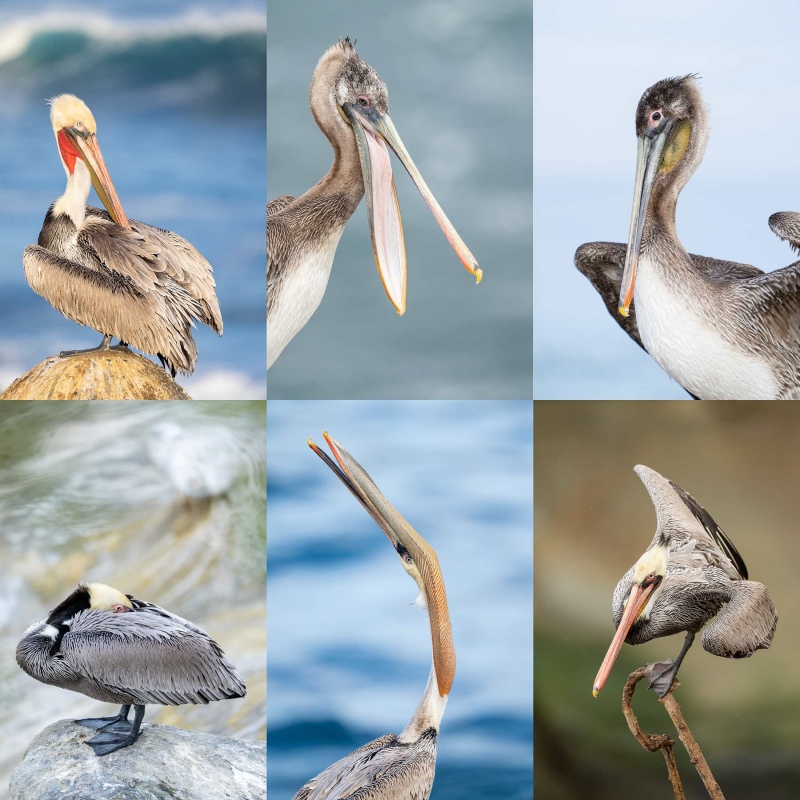
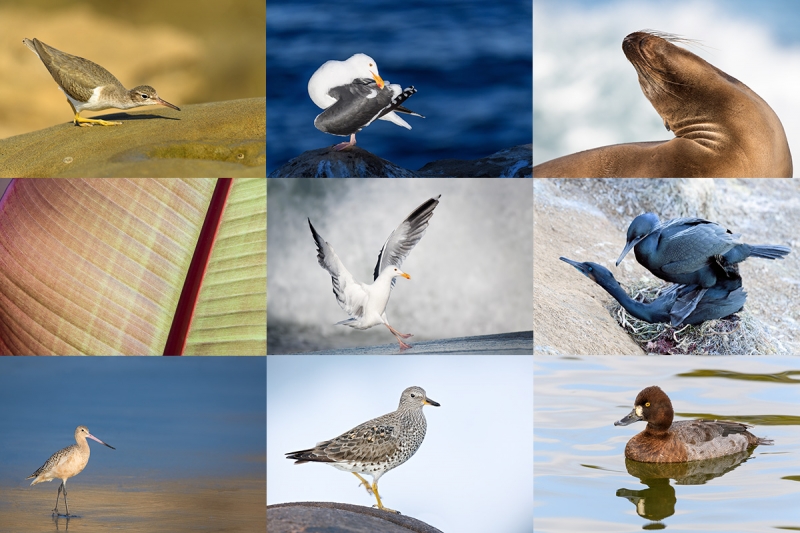

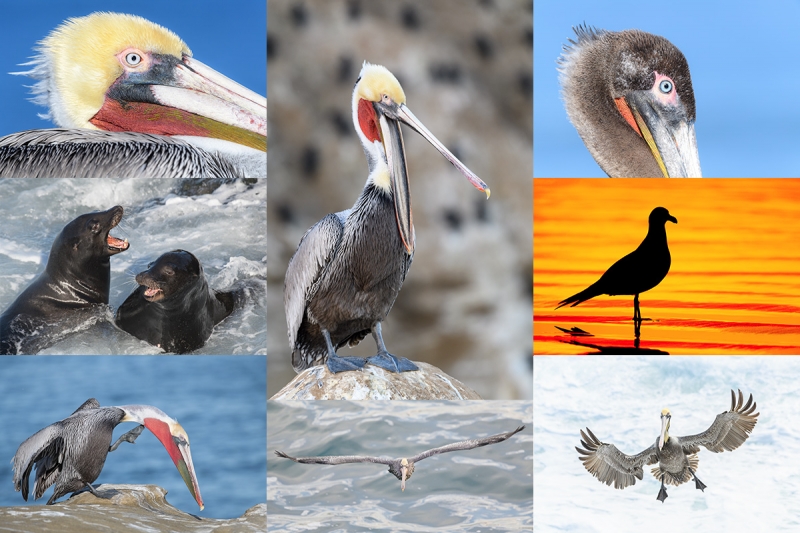














Love that #3. Flying straight up into your face and staring right at you! Look at his face….he’s even suprised you got the the shot.
All 3 images of the Brown Pelican are good and well made and interesting. I also like them all flying in different ways!